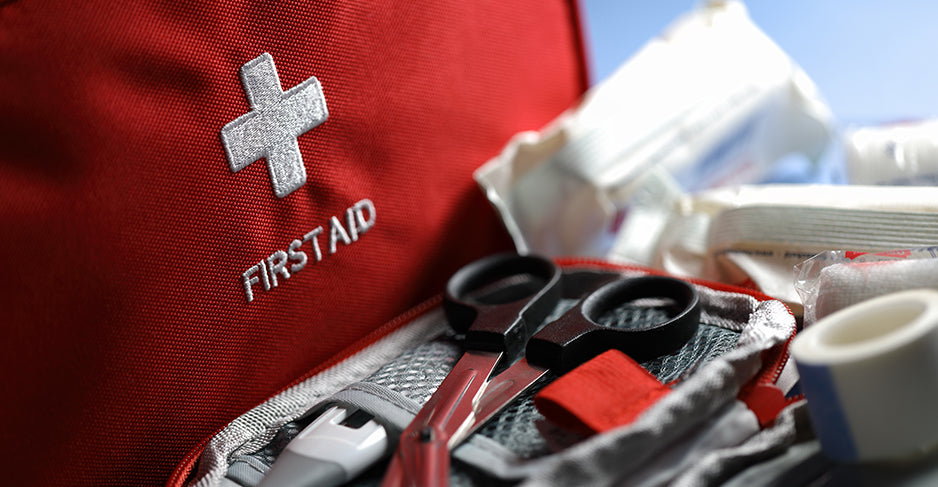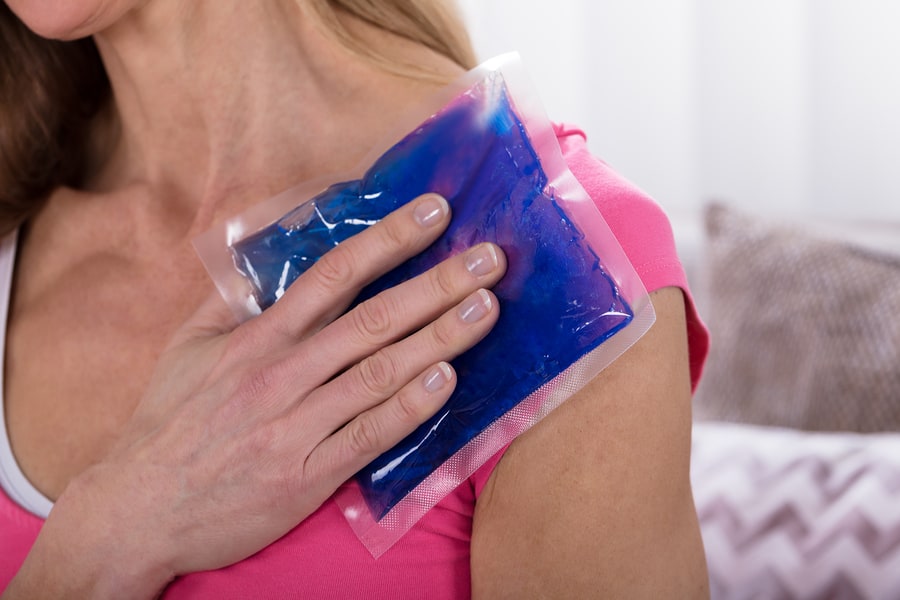
Bunions are a condition that can cause discomfort and pain, often affecting the quality of life for those who suffer from them. This discomfort is usually caused by using the wrong type of footwear, or in some cases, genetics play an essential role in how the toes grow. Fortunately, there are several ways bunions can be treated.
In this article, we will delve into what bunions are, explore both traditional and modern remedies for relief, and specifically focus on utilizing cold gel packs and Kinesiology Tape as treatment options.
How to Relieve Bunion Pain: Understanding Bunions
A bunion, medically known as hallux valgus, is a bony bump formed at the base of the foot, especially the big toe joint. It develops when the big toe pushes against the adjacent toe, causing the joint to protrude outward. Genetic factors, improper footwear, and certain medical conditions like rheumatoid arthritis can cause bunions.
The symptoms of bunions include pain, swelling, redness, and restricted movement of the big toe. As the condition progresses, finding comfortable shoes and engaging in physical activities can become more challenging, leading to a decreased quality of life.
Images scour the internet showcasing slight angular movement of the bone to full-on disfigurement where one toe is pushed under another. These medical conditions can sometimes be treated with prosthetics, but frequently, surgery is used to correct the position of the toes.
Bunions themselves are a medical condition, precisely a type of foot deformity. They are also known as hallux valgus. A bunion is characterized by a bump that develops at the toe's base, causing the big toe to point toward the other toes. This can lead to various ailments and discomfort, including:
- Pain and Discomfort: The bony bump and the misalignment of the big toe can lead to pain, especially when walking or wearing tight shoes.
- Inflammation: The area around the bunion can become inflamed and tender due to friction and pressure from shoes. Pressure marks or redness caused by the shoe are a good indicator of what can be causing a bunion to occur.
- Restricted Foot Movement: Bunions can limit the range of motion of the big toe, making it difficult to move the toe normally.
- Corns and Calluses: The misalignment of the toe can cause friction against footwear, leading to the development of corns and calluses on the affected area.
- Bursitis: The bursa (a fluid-filled sac) located near the joint of the bunion can become inflamed, causing pain and swelling.
- Hammertoe: Over time, the pressure from the misaligned big toe can cause the smaller toes to bend abnormally, resulting in hammertoes.
- Changes in Gait: Individuals with bunions might alter their gait (walking pattern) to compensate for the discomfort, which can lead to problems in other body parts, such as the knees, hips, and lower back.
- Arthritis: In some cases, bunions can develop arthritis in the affected joint, which can cause further pain and mobility issues.
Treatment options for bunions change depending on the severity of the condition and the symptoms. Non-surgical approaches may include wearing roomier shoes, using orthotic inserts, applying ice to reduce inflammation, and taking pain-relief medications. If the bunion causes significant pain and limits daily activities, surgical intervention might be considered to realign the bones and alleviate discomfort.
How to Relieve Bunion Pain: Traditional and Home Remedies
Proper Footwear: Wearing shoes with adequate space for the toes and good arch support is crucial. Avoiding tight, narrow shoes that squeeze the toes together can help alleviate pressure on the bunion. Fashion can be a cruel mistress, and many forgo comfort for design. Unfortunately, there is a steep price to pay for high fashion. It is best to use sensible, comfortable shoes as often as possible.
Toe Spacers: Toe spacers or separators can be placed between the big and adjacent toes. This can help prevent the toes from overlapping and further aggravating the bunion.
Foot Exercises: Gentle exercises focusing on strengthening the muscles around the toes and feet can help improve flexibility and reduce pain. Activities like lifting marbles with your toes or using your toes to scrunch up a towel can be beneficial.
Warm Soaks: Soaking your feet in warm water temporarily relieves pain and swelling. Epsom salts in water can also have a soothing effect.
Ice Packs: Applying ice packs to the bunion area for about 15 minutes can help reduce inflammation and numb the pain. Be sure to wrap the ice pack in a thin cloth to prevent direct contact with the skin.
Orthotic Inserts: Over-the-counter or custom-made orthotic inserts can provide better arch support and cushioning, reducing the pressure on the bunion.
How to Relieve Bunion Pain: Modern Alternatives
While traditional remedies can be effective, modern alternatives offer innovative ways to manage and relieve bunion pain:
- Physical Therapy: A physical therapist can provide precision exercises and techniques to improve foot function and alleviate pain.
- Medications: Non-prescription pain relievers, like ibuprofen or acetaminophen, can help manage pain and inflammation.
- Corticosteroid Injections: In cases of severe pain and inflammation, a corticosteroid injection may be recommended by a healthcare provider to provide immediate relief.
- Bunion Pads and Splints: These devices can help redistribute pressure away from the bunion, helping to reduce pain and promote proper alignment.
Cold Gel Packs:
Cold therapy, or cryotherapy, involves using cold temperatures to alleviate pain and reduce inflammation. Cold gel packs are an effective way to implement this therapy for bunion pain relief. The use of gel cold packs is a valuable tool. These updated versions of the traditional ice bag mold to the form of the foot allow a comfortable experience while treating the discomforting condition caused by the bunion.
Here's how to use them:
- Prepare the Gel Pack: Place the cold gel pack in the freezer for the recommended duration, usually a few hours or as per the manufacturer's instructions.
- Wrap the Gel Pack: Before applying the gel pack to your bunion, wrap the toe with a thin cloth or towel to prevent direct contact with the skin. The most crucial step is to avoid frostbite or skin damage.
- Apply to the Bunion: Place the wrapped gel pack on the bunion area for around 15 minutes. Avoid leaving it on for too long to prevent potential skin damage.
- Wait Between Applications: Allow some time, usually 45 minutes to an hour, before reapplying the gel pack to the bunion. This method prevents overexposure to cold temperatures.
Cold gel packs constrict blood vessels, reduce blood flow to the area, and decrease inflammation and pain. However, they should be used cautiously and not in excess to prevent frostbite or other adverse effects. If, while in use, there is any sensation of pain caused by the cold, remove the gel pack at least one hour before continued use.
K-Tape (Kinesiology Tape)
K-Tape is a stretchy, adhesive tape commonly used for muscle support and pain relief in sports and rehabilitation settings. It can also provide relief for bunion pain through proper application:
- Clean and Dry the Area: Ensure the bunion area is clean and dry before applying K-Tape. This helps the tape adhere properly and stay in place.
- Measure and Cut: Cut a piece of K-Tape to the desired length. The length will depend on the area you must cover and your technique.
- Apply the Tape: Various taping techniques can be used for bunions. One standard method involves applying a strip of tape along the side of the big toe, starting at the toe's base and wrapping it around the bunion area.
- Stretch and Smooth: Gently stretch the K-Tape as you apply it, but not too tightly. Smooth it down to ensure proper adhesion.
- Test Sensitivity: If you experience discomfort, itching, or irritation after applying the tape, remove it immediately. Some individuals may have sensitivities to the adhesive.
K-Tape works by providing support to the muscles and joints, improving circulation, and reducing pain. It also allows for a certain degree of movement while still offering support.
There are several videos online that can serve as a guide on how to apply K-tape for use on the foot. Use these resources as a general guide or consult a chiropractor or physical therapist to best apply for any specific situation.
How to Relieve Bunion Pain: When to Seek Professional Help
While home remedies and modern alternatives can provide relief, it's essential to consult a healthcare professional if bunion pain persists or worsens. They can accurately diagnose the condition, recommend appropriate treatments, and, if necessary, discuss surgical options for severe cases.
Bunion pain can be effectively managed through traditional remedies, modern alternatives, and specialized techniques like cold gel packs and K-Tape. Remember that each individual's experience with bunions may differ, so it's crucial to tailor your approach to what works best for you.
Prioritize your foot health, and don't hesitate to seek professional guidance for persistent or severe bunion pain. Start your journey here!



